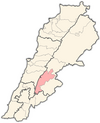Dakoue
Dakoue
Dakoueh, Dekweh | |
|---|---|
Village | |
| Country | |
| Governorate | Beqaa Governorate |
| District | Western Beqaa District |
| Government | |
| • Mayor | Raymond al-Ghajar |
| Population (2004) | |
| • Total | 800 |
| Location | 3 kilometres (1.9 mi) southwest ofMejdel Anjar,Lebanon |
|---|---|
| Coordinates | 33°41′42″N35°53′35″E/ 33.69500°N 35.89306°E |
| History | |
| Periods | Heavy Neolithic,Neolithic,Roman |
| Cultures | Qaraoun culture |
| Site notes | |
| Public access | Unknown |
Dakoue(also spelledDakoueh,orDekweh) is a village located 3 kilometres (1.9 mi) southwest ofMejdel Anjar,Lebanon.It is predominantly inhabited byshepherdsandfarmers.[1][2]
Heavy Neolithic site of the Qaraoun culture
[edit]There is aHeavy Neolithicarchaeological site of theQaraoun culturelocated 700 metres (2,300 ft) northwest of the village where plentiful Heavy Neolithicflintadzes,axes,debitageand waste material were found along with large amounts ofPaleolithicmaterials.[3][4]
Roman temple
[edit]Behind the village there are the ruins of aRoman templethat still retains a centralcourtyardand a frontcolonnadecomposed of three columns. The temple was converted into achurchand achapelcan be accessed via an opening in the west wall. There is a path leading from the temple to an ancientgraveyardwith tombs andsarcophagi.[1][2]George Taylor noted the temple was aligned to the south west and classified it as aProstylos temple.He noted that the decoration of the window,corniceandcapitaldisplayed a design unique in Lebanon.[5]
References
[edit]- ^abCollectif; Jean-Paul Labourdette; Dominique Auzias (1 June 2011).Liban.Petit Futé. pp. 287–.ISBN978-2-7469-4918-8.Retrieved18 September2012.
- ^abDominique Auzias; Jean-Paul Labourdette; Collectif (17 July 2012).Liban 2012 (avec cartes, photos + avis des lecteurs).Petit Futé. pp. 112–.ISBN978-2-7469-6383-2.Retrieved18 September2012.
- ^Moore, A.M.T. (1978).The Neolithic of the Levant.Oxford University, Unpublished Ph.D. Thesis. pp. 444–446.
- ^L. Copeland; P. Wescombe (1966).Inventory of Stone-Age Sites in Lebanon: North, South and East-Central Lebanon.Impr. Catholique.Retrieved29 August2011.
- ^George Taylor (1971).The Roman temples of Lebanon: a pictorial guide. Les temples romains au Liban; guide illustré.Dar el-Machreq Publishers.Retrieved18 September2012.


